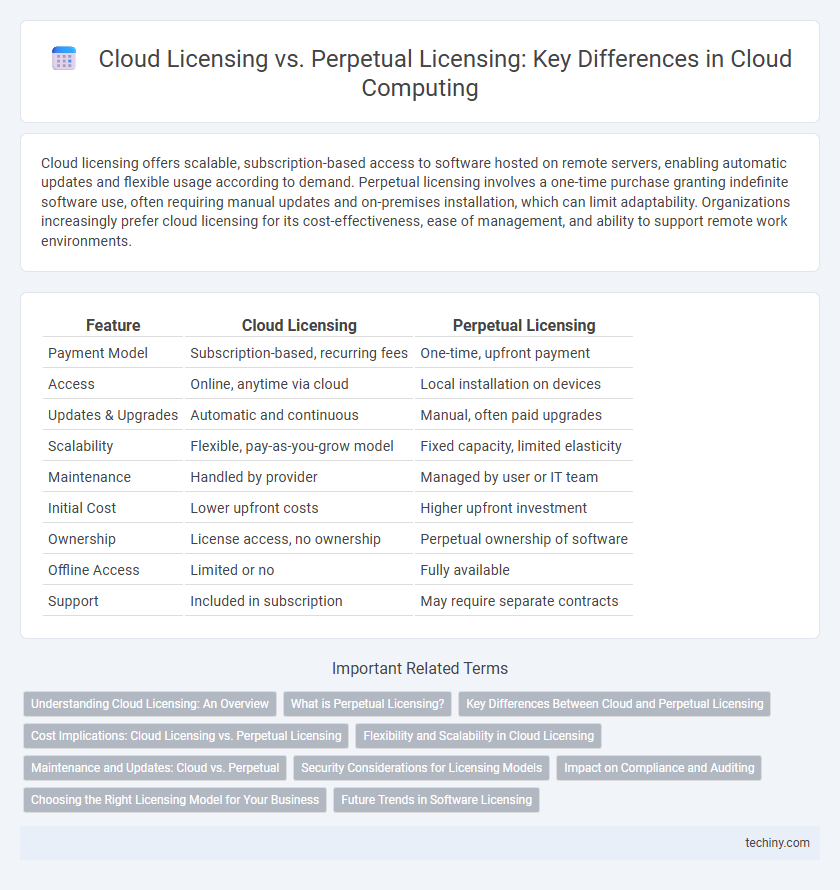Cloud licensing offers scalable, subscription-based access to software hosted on remote servers, enabling automatic updates and flexible usage according to demand. Perpetual licensing involves a one-time purchase granting indefinite software use, often requiring manual updates and on-premises installation, which can limit adaptability. Organizations increasingly prefer cloud licensing for its cost-effectiveness, ease of management, and ability to support remote work environments.
Table of Comparison
| Feature | Cloud Licensing | Perpetual Licensing |
|---|---|---|
| Payment Model | Subscription-based, recurring fees | One-time, upfront payment |
| Access | Online, anytime via cloud | Local installation on devices |
| Updates & Upgrades | Automatic and continuous | Manual, often paid upgrades |
| Scalability | Flexible, pay-as-you-grow model | Fixed capacity, limited elasticity |
| Maintenance | Handled by provider | Managed by user or IT team |
| Initial Cost | Lower upfront costs | Higher upfront investment |
| Ownership | License access, no ownership | Perpetual ownership of software |
| Offline Access | Limited or no | Fully available |
| Support | Included in subscription | May require separate contracts |
Understanding Cloud Licensing: An Overview
Cloud licensing enables businesses to access software via subscription models, offering scalability and regular updates without upfront costs. Unlike perpetual licensing, which requires a one-time purchase and ownership of software, cloud licensing operates on a pay-as-you-go basis, allowing flexibility in resource allocation. Understanding cloud licensing is essential for optimizing IT budgets and ensuring compliance with vendor terms in dynamic computing environments.
What is Perpetual Licensing?
Perpetual licensing grants users the right to use software indefinitely after a one-time purchase, without ongoing fees. This model provides full ownership of the software version purchased, but may lack continuous updates or support beyond an initial period. Organizations often prefer perpetual licenses for predictable costs and control over software assets in on-premises or hybrid cloud environments.
Key Differences Between Cloud and Perpetual Licensing
Cloud licensing offers flexible subscription models with pay-as-you-go pricing, enabling scalable access to software and automatic updates. Perpetual licensing requires a one-time payment for indefinite software use but often lacks ongoing maintenance and upgrade benefits. Cloud licensing supports real-time collaboration and remote access, whereas perpetual licensing typically limits usage to specific devices or locations.
Cost Implications: Cloud Licensing vs. Perpetual Licensing
Cloud licensing often reduces upfront costs by offering subscription-based pricing models that include updates and support, making it more budget-friendly for scaling businesses. Perpetual licensing requires a significant initial investment but may prove cost-effective over the long term if updates and support are minimal or optional. Organizations must evaluate total cost of ownership, including maintenance, upgrades, and scalability, to determine the most cost-efficient licensing model for their cloud computing needs.
Flexibility and Scalability in Cloud Licensing
Cloud licensing offers superior flexibility by allowing businesses to adopt services on-demand and adjust usage based on real-time needs, unlike perpetual licensing which requires upfront purchases with fixed capacities. Scalability in cloud licensing enables instant resource expansion or reduction, ensuring cost-efficiency and alignment with fluctuating workloads. This dynamic model supports agile growth strategies by eliminating constraints associated with traditional software licensing.
Maintenance and Updates: Cloud vs. Perpetual
Cloud licensing includes continuous maintenance and automatic updates as part of the subscription, ensuring software remains current without manual intervention. Perpetual licensing often requires separate maintenance agreements, with updates and support available only during active contracts. This results in cloud models providing more seamless and cost-effective software upkeep compared to the periodic and sometimes costly maintenance associated with perpetual licenses.
Security Considerations for Licensing Models
Cloud licensing offers enhanced security features through centralized updates and real-time threat detection, reducing vulnerabilities compared to perpetual licenses that depend on manual patching. Perpetual licensing requires organizations to maintain their own security infrastructure, increasing the risk of outdated software and exposure to cyberattacks. Cloud licensing also enables more granular control over access permissions and usage monitoring, improving compliance with security standards and regulations.
Impact on Compliance and Auditing
Cloud licensing offers dynamic compliance through real-time usage tracking and automated license management, reducing risks of over- or under-licensing. Perpetual licensing relies on static license counts, making audits more time-consuming and prone to human error, often resulting in compliance gaps. Automated audit trails in cloud environments enhance transparency and simplify regulatory adherence compared to traditional perpetual license auditing.
Choosing the Right Licensing Model for Your Business
Choosing the right licensing model for your business depends on factors like budget flexibility, scalability needs, and deployment preferences. Cloud licensing offers subscription-based access with automatic updates and the ability to scale resources on demand, making it ideal for rapidly changing environments. Perpetual licensing provides a one-time purchase with long-term usage rights, better suited for businesses seeking consistent costs and full control over software installations.
Future Trends in Software Licensing
Cloud licensing models are rapidly evolving with increased adoption of subscription-based access, offering scalability and flexibility that perpetual licensing lacks. Future trends indicate a shift towards usage-based billing and integrated AI-driven license management to optimize cost efficiency and compliance. Enterprises prioritize cloud licensing to leverage continuous updates and seamless multi-device access, aligning with digital transformation goals.
Cloud Licensing vs Perpetual Licensing Infographic

 techiny.com
techiny.com